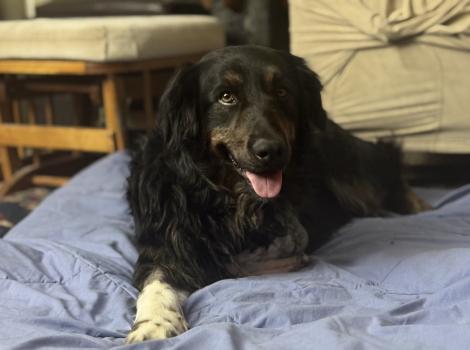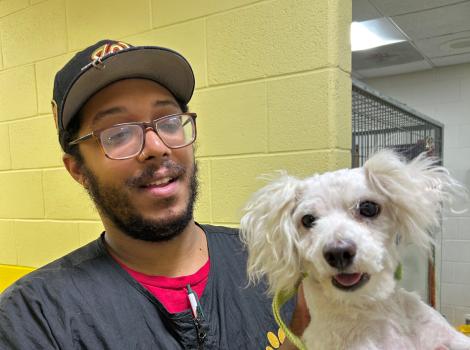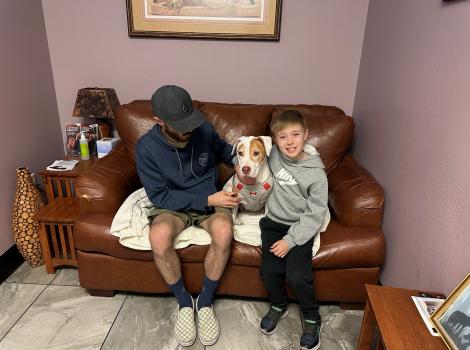Amazing progress at Brownsville animal shelter

When a chocolate brown, pregnant mama dog named Ginger was rescued last May from a construction site, her chances of being adopted (let alone those of her soon-to-be-born pups) appeared slim. The average save rate — the percentage of animals who leave a shelter alive — in the previous 12 months at the Brownsville (Texas) Animal Regulation and Care Center was just 23%.
When Dr. Antonio Caldwell became the municipal shelter’s new deputy director in March, he addressed the problem by making it a priority to get more dogs and cats into happy homes. But he also wanted to take a thorough look at the shelter’s processes and protocols to make sure they met the latest standards.
Although the new deputy director had years of experience in city government, leading an animal shelter staff was a new experience. So when Best Friends Animal Society — which had been in discussion with the city for about a year — deployed Taylor Lefebvre in May as part of Best Friends’ national shelter embed program, the timing was perfect.
“Best Friends did an assessment for us in 2022 that highlighted some critical areas that at the time we didn’t have the bandwidth to starting chipping away at,” says Antonio. “And then when Taylor came in, she brought so much knowledge and expertise, and she’s been a critical component to the guiding, training, and development of our staff.”
Taylor is in the midst of a one-year embed assignment, working side by side with leadership and the shelter staff to implement proven strategies to save more lives. The national shelter embed program, made possible in part by a grant from Maddie’s Fund®, is one of the ways Best Friends is helping shelters reach no-kill by 2025.

Working on the basics
When Taylor arrived, kittens and puppies were dying overnight in the shelter. As it turned out, the problem was their food. “We made some changes that included feeding the animals based on age and also making sure that nursing moms were fed enough so they can produce enough milk for their litters,” says Taylor.
Other changes included getting raised beds for all the animals (no more sleeping on the ground) plus enrichment like chew toys and Kongs for the dogs and hiding boxes for the cats. “These were small fixes, but they really made a big difference in the day-to-day lives of the animals,” says Taylor.
“Best Friends identified problem areas that needed to be tackled right away,” says Antonio. “Making sure all our animals had proper nutrition, getting every animal coming into the shelter vaccinated, and, of course, making sure we had the right strategic plan in place were all important.”

Distemper: All hands on deck
In June, a sudden, full-blown distemper outbreak put everyone on alert. It was an unexpected challenge that put a strain on the already-stretched shelter staff. “The outbreak made us quickly pivot and devote full attention to sanitizing the shelter and making sure every animal was vaccinated prior to entering the building,” says Taylor.
Shelter veterinarian Dr. Logan McAllister praises the staff for catching the outbreak early and being willing to step up and do the extra work to bring things under control.
“It was all hands on deck, including some amazing volunteers from other city departments,” she says. “Because we have such diligent, hardworking staff, we were able handle the situation in about four and a half weeks when it normally would have taken six to eight weeks.”
Reaching out to the community
Brownsville, located just 10 miles from the border with Mexico, has a predominately Hispanic population of just under 190,000; however, despite being in a large metropolitan area, Taylor says the shelter suffers from a lack of visibility. “People generally don’t know about the services offered. And if they lose a pet, it’s not generally known that they can come to the shelter to inquire about them.”
To that end, Best Friends is spreading the word to the general public. “We’re working hard to be more inclusive and welcoming to community members,” says Mia Navedo-Williams, senior multicultural marketing manager for Best Friends. “And it’s more than just translating information into Spanish. It’s about creating relationships by befriending residents and business owners and letting them know what services the shelter provides.”
[Bilingual outreach results in 200 pet adoptions in south Texas]
Working within the local cultural norm is also a point of emphasis, says Taylor. “Down here, it's common for people to have an outdoor dog. So, in addition to sharing information with them about microchips and pet I.D. tags that we share with everyone, we also include tips on how to best care for a dog who is outdoors, including providing appropriate housing, food, and water.
“We also try and talk to people who are surrendering their pets and find out why they are surrendering them,” says Taylor. “We try to encourage them — before surrendering — to take advantage of animal care resources that might help them to keep their pets. Or we might notice that a person has surrendered four litters of cats over the last two years. So we talk with them about getting the mom cat spayed, so it doesn’t continue.”

Renewed commitment to adoption
One of the first things Antonio noticed when he became deputy director was that the shelter’s hours of operation were counterproductive to one of the shelter’s most important lifesaving activities: adoption. Previously, the shelter was open only three hours a day during the week. New expanded hours are now 1 to 6 p.m. from Monday through Friday and 11 a.m. to 5 p.m. on Saturday.
Increasing the use of social media is also helping to get the word out. “We’re trying to make it more welcoming for people to come to the shelter and look for a new best friend,” says Taylor. “And we’re reaching out to Matamoros (sister city to Brownsville just across the border). Now people from Mexico who walk across the bridge to work every day know they can adopt from us.”
More animals are being adopted, thanks to a much simpler, shortened adoption form. “We’ve eliminated such things as asking for written permission from a landlord and needing a driver’s license instead of just an ID. Now it’s a much easier process,” Taylor says.

An eye to the future
Antonio says that the Best Friends national shelter embed program, which has assisted a number of communities around the country, has enabled the Brownsville Animal Regulation and Care Center to make positive changes that have made it possible to save more animals. “It has been tremendously valuable to have someone like Taylor guiding me. Having her on board made a tremendous impact on the success that we’re seeing now.”
That success ― increasing Brownsville’s save rate from 33% in April to 75% in September — portends a much brighter pathway to even greater lifesaving in the months ahead.
[Volunteers team up to support Texas shelters]
Antonio says he’s already projecting six months down the road, when Taylor’s hands-on role at the shelter is complete. “We’re already trying to identify the ‘new Taylor’ because we want to get that person in place to do some shadowing and really get dialed in and ready for when the baton is passed.”

So what happened to Ginger and her pups?
After her rescue, Ginger was staying in one of the shelter offices so that she could have a quiet space and be comfortable until it was time to have her puppies. One day, just before a long weekend, Antonio stopped by to say hi to Ginger.
“She was big as a house, and she had these eyes that melt your whole heart,” he recalls. “So I called my wife and told her that a lady named Ginger was coming home with me. She was 100% on board.”
Two days later with the rain pouring outside, Ginger gave birth to 12 puppies. “Unfortunately, we lost four due to congenital issues,” Antonio says, “but the other eight were strong and have all been adopted into homes.”
Ginger didn’t get adopted out to a new home, but there’s a good reason why. Her eyes had already worked their magic. She was already home, and according to the still-smitten deputy director: “She’s an angel ― my new favorite child.”

Let's make every shelter and every community no-kill by 2025
Our goal at Best Friends is to support all animal shelters in the U.S. in reaching no-kill by 2025. No-kill means saving every dog and cat in a shelter who can be saved, accounting for community safety and good quality of life for pets.
Shelter staff can’t do it alone. Saving animals in shelters is everyone’s responsibility, and it takes support and participation from the community. No-kill is possible when we work together thoughtfully, honestly, and collaboratively.






